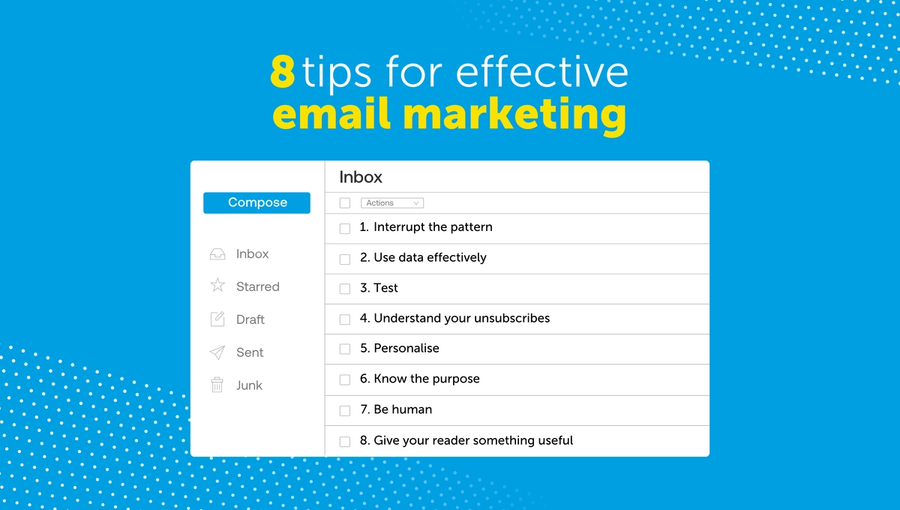Content Marketing & SEO
8 tips for effective email marketing
Email is one of the most profitable and cost-effective marketing channels you can use to reach prospects, nurture leads, engage your target market, and generate repeat sales. Whether in the form of bi-monthly newsletters, direct sales outreach, or a strategic email funnel – if you aren’t email marketing, then you’re missing out.
Done well, email marketing is one of the most effective ways to get your customers’ attention, build relationships, educate them on your brand and services, and ultimately convert them.
With 99% of people checking their inbox every day, it provides ample opportunity to generate ROI.
So, we asked our experts, and found eight ways to make your email marketing more effective.
1. Interrupt the pattern
Take a lesson from marketing’s favourite sister, sales.
In a world where cold callers often start with a bright and breezy, ‘Good morning, Tina, this is Alissa from Toyle Solutions. How are you today?’, the prospect’s guard goes up straight away.
Advice from sales trainers like Benjamin Dennehy suggests that a disarmingly honest approach gets far more engagement.
‘Tina, would you hang up if I told you this is a sales call?’
That’s something they’ve probably not heard before. The pattern gets interrupted. The prospect knows how to respond to a cheesy cold call, but doesn’t have a brush-off lined up for that one.
In the B2B email world, Manicube sent an email with the subject line ‘Do not open this email’. It cuts through the noise of the inbox, and tickles the little rebellious instinct in the brain that tells us not to do what we’re told.
It doesn’t just have to be in the subject line. Apply the same principle to your email body, CTA button, whatever you might choose. Something that interrupts the pattern will impact your reader so much more.
2. Use data effectively
It can seem a mystery why one email performs brilliantly, while another falls flat. The answers are there, but you need to look at the results in detail, and often over a large sample of campaigns.
Unlike a massive ad poster by the motorway, an email campaign tells you in very objective terms who looked at it, when, and what it made them do (open it, click on it, bin it).
Obvious as it sounds, that data is only as valuable as how you interpret and use it.
If you look at the data from an email send, see you got a 22.5% open rate, a 2.03% click rate, and a 0.19% unsubscribe rate, then you smile, nod, and move on to writing the next email, you are not using that data.
You need to consider:
- how one email’s data points interact with each other
- how they relate to other emails you’ve sent.
Did you get an unusually high open rate? Well done.
The question is then ‘why?’. The answer is not ‘because my subject line was incredible’. You’ll only know the real answer if you…
3. Test
One data point should not and cannot be the basis of a strategy. It can be tempting to look at the result of one email and say ‘We got a 30% open rate. It must be because I used a funny word. Funny words in every subject line from now on.’
That could be right, but for the moment it’s a hypothesis. If you test it, you’ll know if it’s right.
An A/B test, you probably know, sends two versions of an email to a segment, with one aspect different. In our subject line example, one would have a funny word in the subject line, one would have a more common word in its place.
In this case, you’re testing the open rate. If the funny subject line performs better, you’ve got the makings of a pattern. Keep testing it, and you’ll get a sample size that’s hard to argue with.
Within one email, you can A/B with a small sample and see what would perform better for a whole segment. Brands that do that for even email tend to see around a 48:1 ROI for their email marketing.
4. Understand your unsubscribes
A loss of subscribers can mean one or more of a few things:
- Your data is no good
- You’ve gone off topic
- You’ve bored your audience
- You email too much
- People who were relevant, aren’t any more
Your unsubscribe rate exists in the context of your other metrics, and you should always view it through the right lens, and build a story of why people opt out of your mailing by putting the pieces together.
For example, if your open rate is brilliant, but your unsubscribe rate is high, that could mean your audience is frustrated that your emails don’t live up to the promise of your subject lines.
A small unsubscribe rate when everything else is healthy is not something to worry about. It’s to be expected. People move on, and some won’t be in your target audience anymore. You always want your data to be more muscle than fat.
Fortunately, you can also ask someone why they unsubscribed. A lot of email service providers provide a questionnaire to unsubscribers, with the option to feedback why they unsubscribed. That takes some of the detective work out of it. Interestingly, excessive emails and a lack of interest are the most common reasons.
5. Personalise
Email personalisation can be as simple as putting the recipient’s first name in the subject line. Something as basic as that can increase your open rate by 26%.
Personalisation can be that and so much more. Your dedication to data has not just rewarded you with a rich picture of your email performance, but of your audience.
You know what an individual has clicked on, what they bought, when they made their first purchase, what they almost bought, and if they only buy with a discount.
With insight like that, you can tailor an email to encourage specific behaviour from specific segments.
Design different versions of the same message. Make one for those who respond more to text, one for those who respond more to images. Send a short email to people who don’t respond to long ones. Wake up your dormant customers with an offer.
When you can reliably make your emails resonate better, why wouldn’t you?
6. Know the purpose
When you get deep into the data, you might find yourself losing sight of the bigger picture. In the case of an email, the question you might forget to ask is ‘What do we want people to do?’
It’s another point that sounds obvious, but all of your analysis, all of your improvements in email metrics, have to be in service of a specific outcome. They themselves are not the outcome.
It’s wonderful if you improve your open rate, but it doesn’t matter how many people open your email if that’s all they do. If you’re aiming to improve clickthrough, what do you want people to do when they’ve clicked through?
Create an email with the outcome at the heart of it. Concentrate on getting your reader to download your whitepaper, visit your website, make an enquiry, or whatever it might be.
Offering a fundamentally appealing proposition is difficult. Tweaking email performance is easy. Sort of.
7. Be human
Email, more than any other marketing medium, is the place to be conversational. If that suits you. Everybody knows they’re not the only one to get your message, but that doesn’t mean you can’t or shouldn’t write as if it’s one person to another.
89% of B2B marketing emails are ‘from’ a company rather than an individual. Just by having an individual listed as the sender, you’ll stand out. You can always take it further, and write like a person, not a brand.
B2B is a context, not a language.
Littering your email with jargon won’t impress many people. It’s tempting to do it, because you want to sound like you know your stuff. But you’ll achieve that much better by showing that you understand your prospects’ business, their priorities, and their problems.
We buy emotionally and justify intellectually. Buzzwords and corporate-speak don't encourage an emotional reaction. Well, maybe irritation, but that’s not the goal.
8. Give your reader something useful
It’s one thing to persuade someone to open your email. It’s another to make them glad they did.
To do that, you don’t have to create something incredible every time. An insightful piece of data or a thoughtful business tip would do the job.
Reliably offering something of value can reward you in the short or long term. You could impress your reader enough to move them along the sales funnel, but even if you don’t convert them, you’ll have left them feeling that emails from you are worth opening. That is worth a lot to any email marketer.
Are you struggling to get what you want from your email campaigns? Get in touch, and we’ll see if we can help. It’s hello@nutcrackeragency.com on email, or call 020 3941 0305.
Share this:






